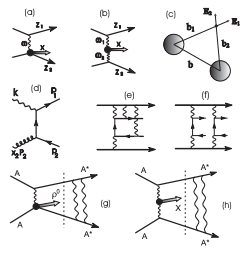Scientific motivations:
The strong electromagnetic (EM) fields surrounding a relativistic heavy-ion can be treated as a flux of linearly polarized quasi-real photons. EM interactions can occur between two ions (including photon-photon and photon-nucleus processes) even when their impact parameter is greater than the nuclear diameter, known as ultra-peripheral collisions (UPC).
Photon-Photon:
Two-photon collisions are fundamental processes that can be used to test quantum electrodynamics (QED) in extreme conditions and search for physics beyond the standard model. The lepton pairs produced from leading order photon-photon scattering possess small pair-pT and are nearly back-to-back in azimuthal angles. In recent years, photon-induced interactions have also been observed in hadronic AA collisions at very low pair-pT. An intriguing “puzzle” has arisen that azimuthal angular correlations of lepton pairs produced via photon-photon scattering appear to be broadened toward central events or small impact parameter (b). Two possible explanations to the observed phenomenon are debated: hardening of initial photon pT with decreasing impact parameter (“initial-state effect”), and/or electromagnetic interactions of produced leptons with the QGP medium in analogy to jet quenching (“final-state effect”). Recent experimental and theoretical developments in controlling the impact parameter of UPC collisions via forward neutron production from mutual Coulomb excitations of two nuclei provide promising opportunities to disentangle initial- and final-state effects. Understanding the origin of the observed dilepton broadening phenomenon will lead to fundamental impacts in many aspects from extreme QED processes, EM properties of the QGP, to searches for new physics beyond the standard model. It is particularly relevant for providing a benchmark to the future scientific program of photo-induced interactions at the EIC.
Photon-Pomeron:
Measurements of photon-nuclear or diffraction processes are one of the most important tools of studying the nucleon and nucleus structure, where a “rapidity gap” is present in some events with no hadronic activity within a rapidity window adjacent to the proton beam direction. In particular, diffractive vector-meson production is of great interest for probing the gluon distributions in nucleons and their modifications in nuclei. The diffractive physics is a subject of interest for a wide range of communities in nuclear and particle physics, going from low energy fixed target experiments to relativistic heavy ion collisions. For instance, the diffractive J/psi vector meson production can be used for gluon imagining in heavy nuclei by measurements of diffractive patterns in the momentum transfer distributions, and it can also be used for probing the Short-range Nuclear Correlations in terms of short-distance gluon dynamics. Moreover, it has been recently realized that light nuclei have a great potential in understanding the nuclear dynamics, especially with experimental capability of tagging forward spectator nucleons. The precise control of the initial-state wave function of light nuclei, e.g., the deuteron, can be an experimental tool to access different configurations on an event-by-event basis. There are still many open questions and challenges in understanding the diffractive physics theoretically, and experimental difficulties for measurements at the future Electron-Ion Collider. Many lessons can be learned from existing experiments with available data and their theoretical interpretations.

